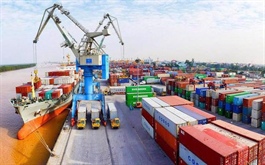Standard Chartered: Viet Nam on course for a strong recovery
Standard Chartered: Viet Nam on course for a strong recovery
Standard Chartered Bank maintains its GDP growth projection for Viet Nam at 6.7 per cent for this year and 7 per cent for 2023.

The forecast is highlighted in the Viet Nam section of the bank’s recently published global research report titled Global Focus – Economic Outlook Q3-2022: Near the tipping point.
“Viet Nam’s economic recovery has shown signs of broadening; macroeconomic indicators continued to recover in June. The recovery may accelerate markedly in second quarter of the year, particularly as tourism reopens after a two-year closure. That said, rising global oil prices may have negative consequences for the economy,” said Tim Leelahaphan, Economist for Thailand and Viet Nam, Standard Chartered Bank.
According to Standard Chartered Bank’s economists, 2022 and 2023 inflation is forecast at 4.2 per cent and 5.5 per cent respectively. Inflation remains under control for now. The fuel component of inflation has increased, while other components have been relatively low. Price pressures – particularly for food and fuel – may increase later in 2022 and in 2023. This could pose a risk to the nascent recovery in domestic consumption. Elevated inflation could also result in search-for-yield behaviour or increase financial instability risks.
Standard Chartered Bank expects the State Bank of Vietnam (SBV) to keep the policy rate on hold at 4 per cent in 2022 and policy normalisation to take place in the fourth quarter of 2023, with a 50 basis point (bps) hike to 4.5 per cent.
“The SBV is likely to stay vigilant against inflation and financial instability, particularly amid ongoing geopolitical risks, although we expect it to stay accommodative this year to support businesses. It has not signalled a change in its stance yet, and Viet Nam’s economic recovery has just started. However, we see a risk that the SBV may raise rates earlier than we expect, given rising inflation and a weaker-than-expected Vietnamese dong – especially if the Fed maintains a relatively hawkish stance,” Tim said.
The UK-backed bank raises its USD-VND forecasts to account for pressure on the goods trade balance from elevated commodity prices, with USD-VND projected at 23,000 at end-Q3-2022 and 22,800 at end-Q4-2022. The bank expects sharp Vietnamese dong appreciation next year, along with a likely rebound in Viet Nam’s current account surplus.
The marcro-economic study also points out three factors could adversely affect Viet Nam’s economic outlook, including new COVID-19 variants, the lifting of US tariffs on imports from China, and a global recession. Pandemic concerns persist, despite Viet Nam’s shift to a ‘living with COVID-19’ policy. On the trade front, the White House has said it is reviewing tariffs on some US imports from China to ease inflation; this could slow the pace of investment relocation from China to Viet Nam, reducing FDI inflows to Viet Nam or even resulting in outflows. Meanwhile, a global recession could hit exporters hard; exports of goods and services are equivalent to more than 100 per cent of Viet Nam’s GDP.





















